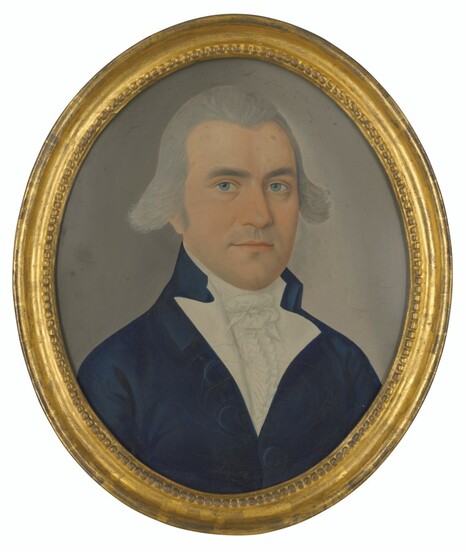Spoilum (fl.c.1774-c.1805), Portrait of George Wilson, East India Company, bust length
Spoilum (fl.c.1774-c.1805)
Portrait of George Wilson, East India Company, bust length
with inscription 'George Wilson / Grandfather's Uncle / Doctor in E. India Coy. / retired to Estate at / Gullen Lodge, Yorks. / (Brought up my Grand - / father' on an old label attached to the backing paper
oil on canvas
oval
171⁄2 x 143⁄4in. (44.4 x 37.4cm.)
in the artist's original frame
A fine portrait by Spoilum, in its original 18th century gilt frame and glass, closely similar in format to the artist's other portraits of officers of the East India Company, George Wilson wearing the dark blue jacket and white cravat of the Company, and presented small bust length, on a grey background. The sitter, given his Yorkshire connections recorded on the label on the backing board, is possibly to be identified with a writer and paymaster in the East India Company, George Wilson, who was born in 1764, the son of William Wilson, James Cook's friend at Ayton Hall, Great Ayton, Yorkshire, and Commodore of the East India Company's fleet.
Spoilum was the first Cantonese artist working for the western market to be identified. His earliest known work (a reverse glass painting) dates to the mid-1770s, and the first works in this oval format to the mid-1780s. He is thought to be the father of Lamqua (Guan Qiaochang), whose early portraits share the format and style of Spoilum's mature portraiture. The present portrait is under its original glass, unlined, on its original laminated stretcher typical of Spoilum's oval portraits, and appears to be unvarnished: 'Once finished, the portrait would have been shipped home unvarnished, the standard advice being that a freshly painted oil should not be varnished for at least six months (but within two years) to prevent the varnish from sinking into the paint while it was still tacky. Several of Spoilum's portraits have survived unvarnished until modern times, partly, no doubt, because they still retain early glass that has evidently protected them from the time they were painted or soon therafter.' (P. Conner, 'The enigma of Spoilum and the origins of China Trade portraiture', The Magazine Antiques, CLIII, no.3, March 1998, p.424).
Please note this lot is the property of a private individual.
Provenance
The sitter, and by descent.
View it on
Estimate
Time, Location
Auction House
Spoilum (fl.c.1774-c.1805)
Portrait of George Wilson, East India Company, bust length
with inscription 'George Wilson / Grandfather's Uncle / Doctor in E. India Coy. / retired to Estate at / Gullen Lodge, Yorks. / (Brought up my Grand - / father' on an old label attached to the backing paper
oil on canvas
oval
171⁄2 x 143⁄4in. (44.4 x 37.4cm.)
in the artist's original frame
A fine portrait by Spoilum, in its original 18th century gilt frame and glass, closely similar in format to the artist's other portraits of officers of the East India Company, George Wilson wearing the dark blue jacket and white cravat of the Company, and presented small bust length, on a grey background. The sitter, given his Yorkshire connections recorded on the label on the backing board, is possibly to be identified with a writer and paymaster in the East India Company, George Wilson, who was born in 1764, the son of William Wilson, James Cook's friend at Ayton Hall, Great Ayton, Yorkshire, and Commodore of the East India Company's fleet.
Spoilum was the first Cantonese artist working for the western market to be identified. His earliest known work (a reverse glass painting) dates to the mid-1770s, and the first works in this oval format to the mid-1780s. He is thought to be the father of Lamqua (Guan Qiaochang), whose early portraits share the format and style of Spoilum's mature portraiture. The present portrait is under its original glass, unlined, on its original laminated stretcher typical of Spoilum's oval portraits, and appears to be unvarnished: 'Once finished, the portrait would have been shipped home unvarnished, the standard advice being that a freshly painted oil should not be varnished for at least six months (but within two years) to prevent the varnish from sinking into the paint while it was still tacky. Several of Spoilum's portraits have survived unvarnished until modern times, partly, no doubt, because they still retain early glass that has evidently protected them from the time they were painted or soon therafter.' (P. Conner, 'The enigma of Spoilum and the origins of China Trade portraiture', The Magazine Antiques, CLIII, no.3, March 1998, p.424).
Please note this lot is the property of a private individual.
Provenance
The sitter, and by descent.



